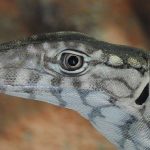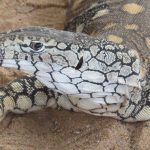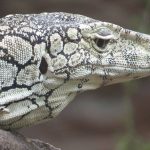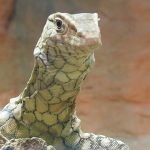PERENTIE
Guardian of Australia’s Arid Heart
In the heart of Australia’s deserts, where ochre sands shimmer beneath an unyielding sun, a quiet giant stalks the landscape. The Perentie, Australia’s largest lizard—moves with both grace and authority, commanding respect from all who share its realm. Standing at the crossroads of myth and reality, the Perentie is not just a reptile, but a living emblem of adaptation and survival.
Portrait of a Titan
The Perentie is a breathtaking sight—up to 2.5 metres long, with a powerful, streamlined body. Its scales are patterned in a mosaic of bronzed and sandy hues, beautifully echoing the colours of the arid lands it calls home. If you were to stand close in the cool morning air, you might notice:
- The rough, pebbly texture of its skin
- The subtle rustle of its claws brushing over red sand
- The faint musk carried on the breeze, an earthy scent of sun-warmed earth and reptile
A Master of Desert Survival
Range and Habitat
The Perentie makes its home across the vast central and western deserts of Australia, surviving in some of the continent’s harshest environments:
| Region | Presence |
|---|---|
| Western Australia | Common |
| Northern Territory | Common |
| Queensland (arid areas) | Occasional |
| South Australia | Occasional |
Behavioural Adaptations
- Thermoregulation: During the sweltering midday heat, Perenties withdraw into cool crevices or burrows, surfacing in the gentle light of dawn and twilight to bask and hunt.
- Hunting Techniques: With keen eyesight and swift reflexes, these apex predators ambush prey, dig using their formidable forelimbs, and even rear up on their hind legs and tail for a better view of the horizon—a spectacle blending power and agility.
- Diet: The Perentie’s menu is as varied as the land itself:
- Insects rustling under stones
- Smaller reptiles scurrying through leaf litter
- Birds startled from low shrubs
- Unwary mammals and, occasionally, carrion
Cultural Significance
For tens of thousands of years, Indigenous Australian cultures have woven the Perentie into their stories, honouring it as a powerful totem—a symbol of strength, wisdom, and endurance. These cultural connections are as enduring as the deserts themselves, reflecting a profound respect for the Perentie’s place in the land.
The Fragile Balance
Conservation Challenges
Though the Perentie is not currently classified as endangered, it faces real threats:
- Habitat Destruction: Expansion of agriculture, mining, and urban development fragments the landscapes these lizards rely upon.
- Invasive Species: Introduced predators and competition for food pose additional pressures.
Conservation Insight
Each Perentie roaming the desert is a reminder of Australia’s rich biodiversity and the delicate web of life that sustains it. Protecting these giants means caring for the broader ecosystems that cradle countless other species.
Conclusion: Nature’s Living Masterpiece
The Perentie is more than just an impressive lizard; it is a beacon of resilience adapted to the challenges of the outback. Its life, woven into both ecological systems and human culture, tells a story of survival against the odds. By learning about and safeguarding such creatures, we preserve not only individual species, but the intricate stories and secrets of Australia’s wild heart.
In every Perentie’s silent gaze lies a lesson: What thrives in the harshest of places is not merely strength, but the wisdom to adapt, endure, and coexist with the world around us. Let us listen, learn, and protect—for their stories are part of our own.




